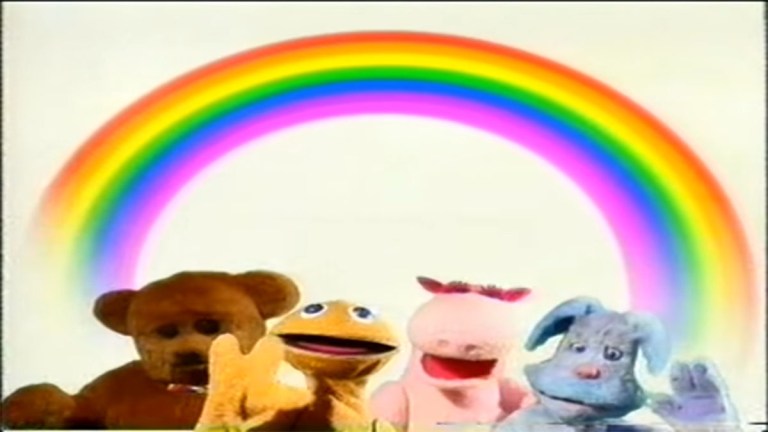Why Rainbow’s 1994 Reboot Failed to Find Gold
No Geoffrey, an eyeless Bungle and a random rabbit? No wonder it didn't work.

Thames TV’s Rainbow was the ordinary, everyday tale of Geoffrey: a grown man who turned his back on family life and a fulfilling career in favour of living in a primary-coloured nightmare with an assortment of irascible talking animals and polyamorous troubadours. There was Bungle, a moody, stroppy wet-blanket of a bear who spent the day naked but inexplicably donned pyjamas at night-time; George, a passive-aggressive pink hippo who hid his Machiavellian evil and simmering sexuality behind a façade of lash-fluttering shyness; and Zippy, a… a… erm… (whatever the hell Zippy was) hellraiser with a rugby-ball head who enjoyed hurling hand grenades of mischief into every interaction. Whenever we think of Rainbow, it’s this cast of four main characters that comes to mind, but they weren’t the original quartet, and neither would they close out the show’s long run on television.
In 1994 – two painful years after the curtain came down on Geoffrey et al’s almost 18-years together – a reboot rose to take its place. This time around, all humans were removed from the menagerie, leaving Zippy, Bungle, George, and a new character called Cleo the Rabbit, in charge of a toy shop. That few are aware of this reboot’s existence – cunningly also called Rainbow – is a testament to its exquisite naffness, but the tale of how we got there, and why it was doomed to failure, is one worth telling.
It’s not every day you get to implicate alleged corporate skulduggery, the IRA, and Margaret Thatcher in the downfall of a children’s television show. And, dear readers, today is that day.
Rainbow Rocks
The MCU doesn’t have the monopoly on Multiverses. Rainbow has had so many soft and hard reboots, and existed in so many alternate televisual realities, that Doctor Strange himself would be hard pressed to keep up with it all. To put it in perspective: there have been almost as many Bungles as James Bonds. And before Rainbow settled on its resident jolly song-smiths – the unsurpassable Rod, Jane and Freddy – Rainbow cycled through a cosmos of crooners, including, at one point, Matthew Corbett – he of second-generation Sooty fame. Both fortunately and unfortunately for a generation of children, Corbett was called away from Rainbow so he could keep a hand in the family business.
The raw ingredients of Rainbow’s winning recipe may have been there from the start, but it took a little tinkering to strike edutainment and pop-culture gold. When the show arrived in 1972 it was trumpeted as a rival to Sesame Street, albeit a very low-budget, culturally homogenous, and restrainedly British riff on the format. The government had only recently relaxed restrictions on television broadcasting hours, creating a lunch-time gap that Rainbow’s creator Pamela Lonsdale moved to plug. The original idea was for the show to be helmed by an eponymous bear called Rainbow, but this idea was shelved, and Bungle, Zippy, and a pair of glove puppets called Sunshine and Mooney took centre-stage alongside the show’s first human presenter David Cook.
Viewers who began with this early incarnation of the show were doubtless left nursing a life-long fear of all things ursine, on account of Bungle’s original design being less cuddly, and more blood-curdlingly terrifying. Bungle’s fur was two-toned, making him look like a polar bear who’d killed a grizzly and gone on to wear its pelt as a trophy. Those meaty, come-to-death arms, and those big, unblinking eyes staring out from a nightmarishly proportioned head invited comparison with a meth-addicted werewolf as imagined by a Manga artist. Truly disturbing. Thankfully, despite the horrific appearance, this iteration of Bungle was played with child-like glee by mild-mannered geek favourite John Leeson, who would go on to provide the voice of the Fourth Doctor’s faithful robot dog ‘K9’ in Doctor Who.
Fast forward a year or two. Sunshine, Mooney and David Cook were out. Bungle had a new look, this time mercifully friendly and non-nightmarish, and a new man inside of him. That man was Stanley Bates, who along with Malcolm Lord would form the backbone of Bungle’s halcyon years as the benign-looking, lumbering, bumbling huff-taker and whistle-blower the nation would come to know and love. Zippy had behind him (or perhaps under him) the decades-long dream team of Roy Skelton and Ronnie Le Drew, voicing and puppeteering respectively. Roy Skelton also provided the voice of George. Skelton was very much the Frank Oz of Rainbow, even down to the heavy-throated uniqueness of his voices, but especially in voicing a creature, like Yoda, who defied proper classification, and whose name came to be a short-hand for all members of his kind.
The icing on the cake was the addition of Geoffrey Hayes to the cast, whose perfect blend of father-figure and friend, mentor and tormented, turned this disparate collection of blood-pressure-popping puppets into a proper family. As the format of the show switched from educational tapas to episode-long narratives, Geoffrey became as much of a respected, avuncular presence in the viewer’s lives as he was in George, Bungle and Zippy’s.
Which is why, after almost 20 years at the top of the Kids’ TV game, what happened to Rainbow and its small-screen icons – particularly Geoffrey – seemed senselessly unfair. And the sting in this tale was a long time coming…
Death on the Box
In 1958, an act of government was passed with the intention of breaking up the BBC’s broadcast monopoly. This created the independent broadcasting network we now know as ITV (or STV if you’re north of the border). The UK was carved into various televisual fiefdoms, with air-time contracts awarded to different operators, or franchisees, across the regions, all bowing to government power. A little like Game of Thrones, but without the nudity.
Throughout Rainbow’s heyday, London’s week-day content was produced and broadcast by Thames Television. Their long and successful stewardship of the airwaves showed no signs of outstaying its welcome, but quality was no defence against the sharp sword of destiny, which fell upon Thames’ neck just after midnight on the 1st of January 1993.
Changes the government brought about to the way franchises were awarded meant that money was king, and rival company Carlton was able to outbid Thames by millions for the lucrative London contract. This sounded the death knell of an era, and marked the end of Rainbow’s pot of gold.
Speculation still abounds that Thames’ demise was brought about by a thirst for revenge on the part of the Thatcher government, angry at the implications of the documentary Death on the Rock, broadcast by Thames as part of its This Week series in April 1988. Death on the Rock questioned and challenged the government’s line on the conduct and culpability of SAS soldiers who had shot three IRA soldiers in Gibraltar only the month before. The government twice tried and failed to have the documentary postponed, and remained bitterly aggrieved thereafter, with some commentators suggesting that the rehaul of the franchise system that led to Thames’ defeat was a deliberate act of punishment. Or to put it another way: the SAS took out Rainbow.
Somewhere, Over the Rainbow
Rainbow was resurrected in 1994 thanks to Tetra Films, who bought the brand and brought it back, this time almost unrecognisably. Though the show had been retooled in the past, that had been while it was still finding its feet, not after it had crystallised into its definitive and most popular form. Any follow-up not forged by the exact same materials was bound to be a bummer. And so it proved.
For starters, the re-worked Rainbow theme-tune ditched the upbeat, percussive, folksy joy of the original in favour of what sounds like an Amiga game played on the panpipes by a sleepy monk. A further Bungle re-cast and redesign didn’t quite plumb the depths of nightmare reached by the character’s first incarnation, but came close enough, removing Bungle’s more anthropomorphic qualities and making him look more like an actual grizzly bear. Perhaps the producers thought to themselves: ‘What we need is a kids’ TV show bear that looks like it could actually take your face off with one swipe. That’ll be a hit with the kiddies.’ They may have put Bungle in a bow-tie, but that did little to soften the obvious horror of him not possessing any eyes; just dark, sunken sockets filled with death and emptiness, like a hunter’s hearth rug come to life on Halloween. We know a song about that, don’t we, children?
Pretty much the only returning member of the crew was Ronnie Le Drew (French-Canadian for ‘Ronnie The Drew’), who came back not only to puppet Zippy, but to voice him, too, on the grounds that Tetra lacked the resources of Thames, and couldn’t afford to hire Roy Skelton, too. Ronnie even had to re-audition for the part. While Le Drew did a passable job of Zippy, George came to sound like a munchkin having a nervous breakdown on helium.
Poor Geoffrey Hayes had the bitterest pill to swallow. According to Le Drew, Hayes only found out that he hadn’t been included in the reboot by reading about it in the newspaper. So began a long spell in the televisual wilderness for this aspiring stage-and-screen actor, who pre-Rainbow had been in long-running police procedural Z Cars. That spell pretty much only ended when he passed away in 2018. He’d become so synonymous with Bungle, Zippy, and George that his own brand never recovered – despite a presenting role in the short-lived kids’ TV show Mole in the Hole, and various ironic post-Rainbow appearances, including dancing with Shaun Ryder to a new techno mix of the Rainbow theme-tune on Channel 4’s The Word.
As the characters of Bungle, Zippy and George had been ciphers for children at different stages of development, it made little sense to unleash them without a human chaperone in the wider fictional world, running a shop of all things. This was doubtless part of the still-continuing trend of removing authority figures from kids’ TV, or side-lining them by making them as gormless as Bungle, in favour of placing other kids or kid-like adults at the helm. Kids relate better to other kids, right? Hmmm. Did we learn nothing from Lord of the Flies? This reboot of Rainbow and another one in 1997 (better received but still both regrettable and forgettable), closed shop almost as soon as they had opened, the producers realising too late that the magic of the show hadn’t been in the brand, but in its cast.
Let’s give Geoffrey Hayes the final word, from an interview with The Guardian in 2002: “It came as a shock when the phone stopped ringing in 1994. I got depressed for a while, but it didn’t last long. I took the attitude ‘What will be, will be’. They were fantastic years, and I don’t regret them. I’ve been really lucky.”
And so say we all.
